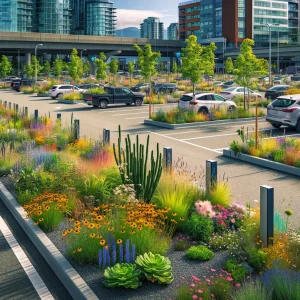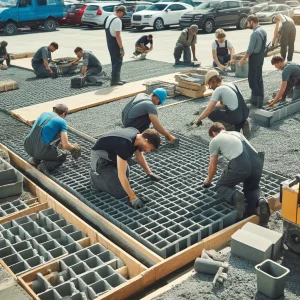As urban spaces expand, the demand for more thoughtful, sustainable design in every development aspect has become crucial. One such area ripe for innovation is the parking lot—a familiar yet overlooked contributor to urban environmental issues. In British Columbia, forward-thinking landscapers and urban planners are in charge of transforming these spaces into eco-friendly landscapes. Consequently, we explore how sustainable practices are integrated into parking lot designs, their benefits, and the policies driving this change.

Why Focus on Parking Lots?
Traditional parking lots are typically vast expanses of impervious surfaces that contribute to urban heat island effects, water runoff pollution, and biodiversity loss. We can mitigate these issues significantly by reimagining these spaces with sustainability in mind. Moreover, sustainable parking lot landscapes enhance the area’s aesthetic value, support environmental conservation efforts, and reduce maintenance costs over time.

Innovative Landscaping Techniques
Permeable Pavement: This technique is pivotal in managing stormwater runoff. Permeable materials allow water to seep through the surface into the ground below, reducing runoff and filtering pollutants. Furthermore, installation guidelines suggest a substrate depth specific to the soil and rainfall patterns of British Columbia, ensuring effectiveness and durability.
Native Vegetation: Incorporating plant species native to British Columbia supports local wildlife by providing habitats and food sources which require less water and maintenance. Additionally, designing with native plants can create biologically diverse ecosystems within urban areas.

Real-World Examples in British Columbia
Several parking areas in British Columbia have been transformed using these techniques. For instance, a shopping center in Vancouver has implemented a fully permeable parking lot combined with rain gardens around the perimeters. Together, these features control runoff, reduce the burden on municipal stormwater systems and enhance local biodiversity.



Economic and Environmental Benefits
Long-term maintenance and water management savings often offset the initial costs of implementing sustainable parking solutions. For example, while permeable pavements are more expensive upfront, they reduce the need for traditional stormwater management systems, resulting in lower overall costs for local governments and private entities.


Maintenance and Policy Support
The long-term maintenance of sustainable parking lots involves regular inspection and cleaning to ensure permeable surfaces remain effective. Additionally, British Columbia offers several incentives, including grants and tax reductions, for businesses and municipalities to adopt these practices.
The Role of Policy
British Columbia’s progressive environmental policies have been instrumental in promoting sustainable landscaping in parking areas. These policies not only incentivize the adoption of green technologies but also set standards that ensure the long-term success of these initiatives.
In conclusion, for British Columbia and beyond landscapers, the move towards sustainable parking lot landscapes represents both a challenge and an opportunity. By embracing innovative techniques and leveraging local policies, they can play a pivotal role in shaping greener, more sustainable urban environments. As these practices become more widespread, they offer a blueprint for others to follow, demonstrating that even the most mundane urban spaces can be transformed into valuable ecological assets.